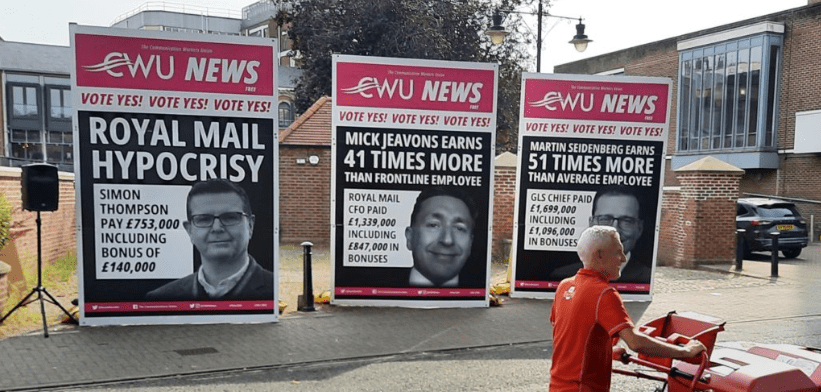By a CWU member
The result of the ballot of CWU members in Royal Mail against a pay imposition of 2% gave an overwhelming vote in favour of strike action – 97% – a 77% turnout. The result is a reflection of the massive discontent felt by the workforce.
Inflation is currently running at 9.4% and likely to increase further, with the bank of England predicting 11% by October, when the price cap on energy bills is lifted. At the moment 2% represents a real pay cut of 7.4%.
In May, Royal Mail announced that profits were up by 8% to £758 million with profit from its domestic operations up by 20.9% to £416 million. For shareholders this has meant a dividend yield of 12.98% for the last year. The CEO of Royal Mail, Simon Thompson, was last year paid £753,000, made up of a salary of £525,000, an incentive plan bonus of £142,000 and pension benefits of £86,000.
While the pay ballot was taking place, Royal Mail announced that they will be imposing changes to in terms and conditions. The changes include annualised (banking) hours. This means flexible hours with different working hours over the course of the year. There could be compulsory extended deliveries if the workload is high, adding the hours to a ‘bank’ and if volumes are low and delivery is finished early then the hours are taken from the ‘bank’.
All deliveries and collections are currently monitored with a hand-held personal digital assistant (PDA) which uses global positioning satellite technology to track movement and performance, even walking speed. Having a bank of hours would mean a big reduction in earnings from overtime payments, particularly with Christmas pressure payments.
Royal Mail also announced that Sunday working would be compulsory as normal duty, without Sunday premium pay. They want laterstart times, of up to three hours. This disrupts current working arrangements with later finishes. It will also reduce Royal mail costs in shift payments and the nightshift workforce in processing centres and put the Airhub operations under threat as the lorry fleet will take over transportation of all mail.
Two-tier workforce proposal
Royal Mail want to introduce a two-tier workforce, with all new entrants on lower rates of pay. They will be paid £1,580 less per year and will work a 40-hour week instead of a 37-hour week.Legacy allowances will be removed, including Postal Higher Grade, PBS (Performance Bonus Scheme) supplement and MGV (Medium Goods Vehicles) supplement, that all formed part of the way forward agreement protection in 2000.
There is an attack on sick pay agreements. The proposed new arrangement will mean that after the first absence in a 12-month period, only Statutory Sick Pay (SSP) would be paid for the first week of absence. After three absences, or 12 days of absence over a 12-month period, an attendance review will be issued. And for those leaving the business through ill health, there is a reduction of the 34-week compensation payments by 1 week for every 1 week of contractual sick pay received.

A second ballot for strike action on these issues has been issued and the result will be known on the August 17. Strike action will only occur after that date on both pay and conditions. The anger of the workforce over these proposals is just as high as the anger over pay and it will almost certainly result in a massive yes vote. It is an insult to the workforce who were deemed essential workers during the Covid pandemic and faced the dangers of working through the pandemic and which enabled the huge profits announced for Royal Mail.
Many workers are in conflict over the squeeze on living standards
Royal Mail workers are not the only workers who are in conflict. Civil Servants have also had a 2% pay rise imposed by the government and rail workers were also offered 2%, that has now been increased to 4% following their successful strike action. The Royal College of Nursing (RCN) have called a ballot for strike action after it was announced that NHS staff including nurses, midwives and paramedics will get 4%, although cleaners and porters will get 9.3%. Doctors and dentists will receive 4.5% and teachers have been awarded 5% – although newly qualified teachers get 8.9%. This follows years of below inflation rises that has led to a massive decline in living standards.
It is all part of a coordinated attack from government and employers. Legislation has been altered to allow employers to use scab labour to replace workers on strike. Potential damages against unions have been raised from £250,000 to £1 million when strike action has been found by the court to be unlawful. In addition, the Tory leadership candidate, Liz Truss, has called for additional restrictions to the right to take industrial action.
In response Mick Lynch, the General Secretary of the Rail, Maritime and Transport (RMT) union, said coordinated and synchronised industrial action would be needed if legislation is brought in. He said the very dangerous situation risks taking the country back to Victorian times. The TUC should be calling now for co-ordinated strike action by all the unions. Such a call would rally all workers and give them the confidence to defeat the attacks. It would certainly help us in Royal Mail to defeat the biggest attack on working conditions that anyone can remember.
[Picture at top…CWU members lobbied the annual general meeting of Royal Mail plc]



